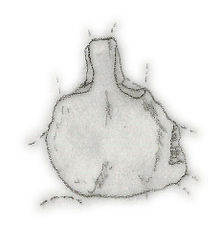Yaverlandia
| Yaverlandia Temporal range: Early Cretaceous,
| |
|---|---|

| |
| Skull | |
| Scientific classification | |
| Kingdom: | Animalia |
| Phylum: | Chordata |
| Clade: | Dinosauria |
| Clade: | Saurischia |
| Clade: | Theropoda |
| Clade: | Maniraptoriformes |
| Clade: | Maniraptora |
| Genus: | †Yaverlandia Galton, 1971 |
| Species: | †Y. bitholus
|
| Binomial name | |
| †Yaverlandia bitholus Galton, 1971
| |
Yaverlandia is a genus of maniraptoran dinosaur. Known from a partial fossil skull (MIWG 1530) found in Lower Cretaceous strata of the Wessex Formation (; Vectis Formation) on the Isle of Wight,[1][2][3] it was described as the earliest known member of the pachycephalosaurid family, but research by Darren Naish shows it to have actually been a theropod, seemingly a maniraptoran.[4] Yaverlandia was named from where it was found, Yaverland Point/ Yaverland Battery. It was about 3 ft (1 m) in length and 1 ft (30 cm) in height.[5] The type species is Yaverlandia bitholus.[6]
Discovery and naming[]
The holotype skull of Y. bitholus was discovered in 1930, in England.[7][8] It was referred to as an iguanodontid of the genus Vectisaurus in 1936.[9] When Steel (1969) followed Hulke (1879)[10] in listing Vectisaurus as an iguanodontid, Peter Malcolm Galton (1971) named the fossil as Yaverlandia, which he described as a pachycephalosaurid since the skull of Yaverlandia was different than that of Vectisaurus (Mantellisaurus).[6] Sullivan (2000), Sereno (2000)[11] Naish (2006; unpublished thesis), Sullivan (2006)[12] and Naish (2008)[4] all re-classified Yaverlandia as a maniraptoran. In 2012 additional remains were reported, but these have not been described.[13]
References[]
- ^ Weishampel, David B; et al. (2004). "Dinosaur distribution (Early Cretaceous, Europe)". In: Weishampel, David B.; Dodson, Peter; and Osmólska, Halszka (eds.): The Dinosauria, 2nd, Berkeley: University of California Press. Pp. 556-563. ISBN 0-520-24209-2.
- ^ Batten, D. J. (ed.) 2011. English Wealden Fossils. The Palaeontological Association, London.
- ^ "Magnetostratigraphy of the Lower Cretaceous Vectis Formation (Wealden Group) on the Isle of Wight, Southern England."
- ^ a b Naish, Darren; Martill, David M. (2008). "Dinosaurs of Great Britain and the role of the Geological Society of London in their discovery: Ornithischia". Journal of the Geological Society, London. 165 (3): 613–623. doi:10.1144/0016-76492007-154.
- ^ Sullivan, R.M. 2006. A taxonomic review of the Pachycephalosauridae (Dinosauria: Ornithischia). New Mexico Museum of Natural History and Science Bulletin 35:347-365
- ^ a b Galton, P.M. (1971) "A primitive dome-headed dinosaur (Ornithischia: Pachycephalosauridae) from the Lower Cretaceous of England and the function of the dome of pachycephalosaurids". Journal of Paleontology, Vol. 45, No. 1, Pages 40–47.
- ^ Watson, D.M.S (1930) Proceedings of the Isle of Wight Natural History Society. 2, 60.
- ^ BBC: Dinosaurs of The Isle of Wight - Ornithischians
- ^ Swinton, 1936
- ^ Vectisaurus valdensis, a new Wealden Dinosaur (J. W. Hulke) Quarterly Journal of the Geological Society, 35, 421-424, 1 February 1879, https://doi.org/10.1144/GSL.JGS.1879.035.01-04.27
- ^ Sereno, P. C., 2000: The fossil record, systematics and evolution of pachycephalosaurs and ceratopsians from Asia. 480-516 in Benton, M. J., Shishkin, M. A., Unvin, D. M. & Kurochkin, E. N., (eds.) 2000: The Age of Dinosaurs in Russia and Mongolia. Cambridge University Press, Cambridge, xxxix-696
- ^ Sullivan, R. M., 2006: A taxonomic review of the Pachycephalosauridae (Dinosauria: Ornithischia). New Mexico Museum of Natural History Bulletin 35: 347-365
- ^ "English Wealden fossils: an update". Proceedings of the Geologists' Association. 129 (2): 171–201. 2018-04-01. doi:10.1016/j.pgeola.2018.02.007. ISSN 0016-7878.
- Early Cretaceous dinosaurs of Europe
- Prehistoric maniraptorans
- Isle of Wight
- Fossil taxa described in 1971
- Taxa named by Peter Galton
- Theropod stubs















